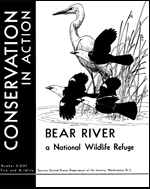US Fish & Wildlife Service
Date of this Version
6-2015
Citation
Wright GD, Frey JK. 2015. Habitat selection by the endangered New Mexico meadow jumping mouse on an irrigated floodplain. Journal of Fish and Wildlife Management 6(1):112–129; e1944-687X. doi: 10.3996/062014-JFWM-044
Abstract
The New Mexico meadow jumping mouse Zapus hudsonius luteus is endemic to the American Southwest. It has undergone severe declines in distribution over the past century and it has been listed as endangered under the Endangered Species Act. The goal of this study was to determine current status and habitat selection by the New Mexico meadow jumping mouse at three spatial scales (landscape, macrohabitat, microhabitat) on a managed highorder floodplain. We hypothesized that the New Mexico meadow jumping mouse is a habitat specialist that might rely on specific habitat components at multiple spatial scales. The study occurred at Bosque del Apache National Wildlife Refuge, New Mexico. In comparison with the status of the species 2 decades ago, the New Mexico meadow jumping mouse was rare, with only 29 individuals captured. Trapping results and radiotelemetry of 20 individuals revealed that the current population existed along 2.7 km of a single irrigation canal. At the landscape scale, the distribution of the New Mexico meadow jumping mouse was determined by selection of canals, water, foxtail barley Hordeum jubatum herbaceous temporarily flooded association, and narrowleaf willow Salix exigua mesic graminoids shrubland association. At the macrohabitat scale, jumping mice selected canals and Hordeum jubatum herbaceous temporarily flooded association. At the microhabitat scale, jumping mice selected areas that were near water and contained moist soils, dense herbaceous canopy cover, dogbane Apocynum cannabinum, foxtail barley, and common threesquare Schoenoplectus pungens; jumping mice avoided habitats represented by eight plant species, including mule-fat Baccharis salicifolia, kochia Bassia scoparia, and saltcedar Tamarix ramosissima. Jumping mice only occurred where there is an overlap of the required habitats at all three scales and this may be a key limiting factor for the New Mexico meadow jumping mice at Bosque del Apache National Wildlife Refuge. Habitats used by jumping mice during maternal nesting and hibernation contained more woody plants and woody debris than at other times of their life cycle. Information gained from this study can help land managers protect and create habitat conditions required by the New Mexico meadow jumping mouse.


Comments
Used by permission.